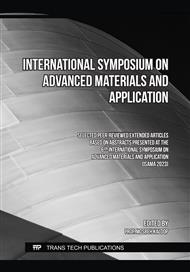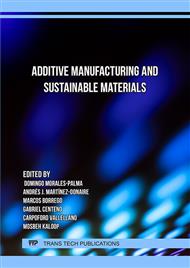[1]
S. Salhofer, M. Spitzbart, K. Maurer, Recycling of LCD screen in Europe – state of the art and challenges, in the 18th CIRP International Conference on Life Cycle Engineering, May 2nd - 4th Braunschweig, Germany, 2011.
DOI: 10.1007/978-3-642-19692-8_78
Google Scholar
[2]
M. Buzatu, N.B. Milea, Recycling the liquid crystal displays, U.P.B. Sci. Bull, Series B, 70 (2008) 93-102.
Google Scholar
[3]
K. Kim and K. Kim, Valuable recycling of waste glass generated from liquid crystal display panel industry, J. Clean. Prod., 174 (2018) 191-198.
DOI: 10.1016/j.jclepro.2017.10.326
Google Scholar
[4]
Y. Liu, J. Xie, P. Hao, Y. Shi, Y. Xu, X. Ding, Study of factors affecting properties of foam glass made from waste glass, J. Renew. Mater., 9 (2021) 237-253.
DOI: 10.32604/jrm.2021.012228
Google Scholar
[5]
D.U. Tulyaganov, et. al., Preparation and characterization of high compressive strength foams from sheet glass, J. Porous Mater., 13. P.133-139, 2006.
DOI: 10.1007/s10934-006-7014-9
Google Scholar
[6]
M. Assefi, et. al., High strength glass foams recycled from LCD waste screens for insulation application, J. Clean. Prod.,280 (2021) 124311.
DOI: 10.1016/j.jclepro.2020.124311
Google Scholar
[7]
T. Patcharawit, et. al., Hybrid recovery of copper and silver from PV ribbon and ag finger of EOL solar panels, Int. J. Power Energy Eng.,16 (2022) 89-99.
Google Scholar
[8]
T. Y. Lim, A study on the fabrication of foamed glass by using refused coal ore and its physical properties, J. Korean Cryst. Growth Cryst. Technol., 21 (2011) 266-273.
DOI: 10.6111/jkcgct.2011.21.6.266
Google Scholar
[9]
A. Passerone, R. Sangiorgi, G. Valbusa, Surface tension and density of molten glasses in the system La2O3-Na2Si2O5, Ceram. Int., 5 (1979) 18-22.
DOI: 10.1016/0390-5519(79)90005-x
Google Scholar
[10]
M. F. S. M. Shofria, M. H. M. Zaida, R. A. A. Wahab, K. A. Matori, S. Hj. A, Aziza, Y. W. Fen, The effect of boron substitution on the glass-forming ability, phase transformation and optical performance of zinc-boro-soda-lime-silicate glasses, J. Mater. Res. Technol., 9 (2020) 6987–6993.
DOI: 10.1016/j.jmrt.2020.05.022
Google Scholar
[11]
F. Drünert, F. Lind, P. Vontobel, E.I. Kamitsos, L. Wondraczek, D. Möncke, Borosilicate glass layers on Mycenaean glass: Surface alterations by glass–borax–gold interactions, J. Non-Cryst. Solids: X, 3 (2019) 100020.
DOI: 10.1016/j.nocx.2019.100020
Google Scholar
[12]
ASTM 552-22 Standard specification for cellular glass thermal insulation.
Google Scholar
[13]
L. Han, F. Li, X. Deng, J. Wang, H. Zhang, S. Zhang, Foam-gelcasting preparation, microstructure and thermal insulation performance of porous diatomite ceramics with hierarchical pore structures, J. Eur. Ceram. Soc., 37 (2017) 2717–2725.
DOI: 10.1016/j.jeurceramsoc.2017.02.032
Google Scholar
[14]
E. C. Robertson, Thermal properties of rocks, United States Department of the Interior Geological Survey, Open-File Report 88-441, Virginia, United State (1988) 110.
Google Scholar



